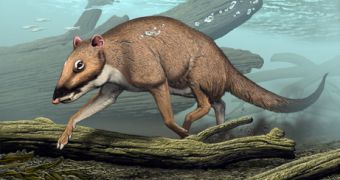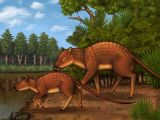The blue whale can be up to 33 m (100 ft) in length and weigh 181 tons, yet its recently described ancestor was just a large cat sized deerlike hoofed mammal.
The semiaquatic creature, called Indohyus, inhabited southern Asia some 48 million years ago, and has been described in a research published in the journal "Nature". It was an artiodactyl (even-toed ungulate), from the group comprising pigs, sheep, hippos, deer and giraffes. This matches DNA tests showing that the hippopotamus is the closest living relative of the whale.
Still, the first fossil hippos are 13 million years old, 35 million years after whales split from ground artiodactyls. The team led by paleontologist Hans Thewissen, of Northeastern Ohio Universities Colleges of Medicine and Pharmacy, investigated hundreds of Indohyus fossils that had been discovered in mudstone, in Indian Kashmir.
"We think that Indohyus was living there in little herds and that a whole bunch of these animals died. Their bones were then washed into this river and they were all buried together", said Thewissen.
"The fossils show distinct features that suggest the ancient ungulates, or hoofed mammals, are the long-sought 'missing links' in the evolution of whales. In particular, the structure of the animal's skull and ears show that Indohyus was closely related to whales", the authors wrote.
One side ear was much thicker than the other, a trait characteristic to cetaceans (whales and dolphins). Bone structure also pointed that the animal spent a lot of time in the water.
"The limb bones had a thick, dense outer layer-a feature often seen in modern aquatic mammals, such as hippos, that require extra ballast", wrote the authors.
"It allows them to walk on the bottom of the river without their buoyancy pushing them up and making them float. So [Indohyus] was also a wader in water", said Thewissen.
"In addition, the ratios of chemical clues called isotopes in the creature's teeth are characteristic of animals that ingest water while feeding", noted the researchers.
Chemical analyses of the teeth showed that Indohyus ate plants, despite the concept that first whales entered the water in order to hunt fish.
"Clearly, this is not the case. Indohyus is a plant-eater and already aquatic. Apparently the dietary shift to hunting animals [as modern whales do] came later than the habitat shift to water", said Thewissen.
The authors believe Indohyus took refuge in the water to escape land predators, just like the African mouse deer, a primitive living artiodactyl from the rain forest, which foraged on land but dived into rivers when feeling chased.

 14 DAY TRIAL //
14 DAY TRIAL // 
